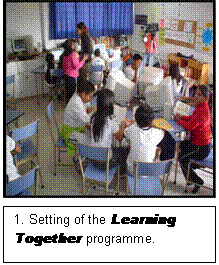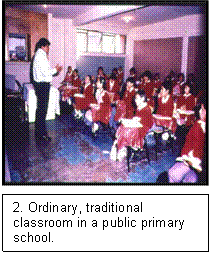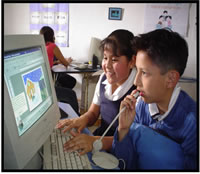MirandaNet presence in the UK and throughout the World
International | Africa | Bangladesh | Chile | China | CzechMiranda | Japan | Macedonia | Mexico | MiraNet | MirandaNorth | Poland | Regional | Romania | Star | Taiwan | Thailand | UK-Japan Science | UK-China Links | USA
 “Learning
Together”
“Learning
Together”
The Creation of Communities of Inquiry Supported by ICT
S.M. Rojas-Drummond*, C.D. Albarrán, M.G. Vega, M. Zúñiga & M. Vélez
Faculty of Psychology, National Autonomous University of Mexico
- Introduction
- General Description of the Programme
- Implementation of the Programme in each Grade
- Conclusions
- Bibliography
II. General Description of the Programme
 The
programme “Learning Together” is carried out in a multipurpose
room within the primary school, designed ex-professo. It is equipped
with modular furniture that allows for a diversity of group activities, as
well as a small library and computers connected to the Internet.
The
programme “Learning Together” is carried out in a multipurpose
room within the primary school, designed ex-professo. It is equipped
with modular furniture that allows for a diversity of group activities, as
well as a small library and computers connected to the Internet.
The programme is implemented with 4th, 5th and 6th grade students (from 9 to 12 years old). All throughout the academic year, the respective participating teachers and students of each classroom come once a week to this setting for a 90 min. session. Each session is coordinated by the respective teacher with the support of several university researchers (“facilitators”). Before and during implementation of the programme, teachers and researchers work in close collaboration to design and carry out all the activities.
The sessions are organized in modules. Each module is designed to develop diverse target general and specific abilities in the students. These are adapted to each grade and increase in degree of sophistication, been integrated with each other gradually as children advance throughout the programme.
Among the target abilities strengthened by each of the modules are: 1) collaboration and communication; 2) problem solving; 3) general psycholinguistic abilities; 4) comprehension and production of literary texts; 5) comprehension and production of communicative and argumentative texts, and 6) comprehension and production of expository texts.
 The
first 3 modules are common to all 3 grades, while the 4th module is implemented
only in 4th grade, the 5th module only in 5th grade and the 6th module only
in 6th grade. This is because in each grade a special discursive genre is
privileged and students create team projects which involve several functional
uses of oral and written language, as well as ICT. However, the projects in
each case are geared towards developing competence in the use of that particular
genre. These projects are presented at the end of the year in a “cultural
fair”, with the participation of the whole learning community as well
as a broader audience.
The
first 3 modules are common to all 3 grades, while the 4th module is implemented
only in 4th grade, the 5th module only in 5th grade and the 6th module only
in 6th grade. This is because in each grade a special discursive genre is
privileged and students create team projects which involve several functional
uses of oral and written language, as well as ICT. However, the projects in
each case are geared towards developing competence in the use of that particular
genre. These projects are presented at the end of the year in a “cultural
fair”, with the participation of the whole learning community as well
as a broader audience.
Some of the teaching-learning strategies used by teachers and facilitators to implement the programme are: 1) the creation of learning environments rich in social interaction where the diverse activities carried out are mediated by a variety of cultural artifacts; 2) guided participation between experts and novices (e.g. Rogoff, 1990) where adults scaffold children’s learning activities; 3) cooperative learning where peers work jointly in the creation of “Intermental Development Zones”, as well as in the co-construction of knowledge (Mercer, 2000); and 4) the promotion of sociocognitive styles of interaction and discourse (Rojas-Drummond, 2000).
[Next section: Implementation of the Programme in each Grade]
[Back]

